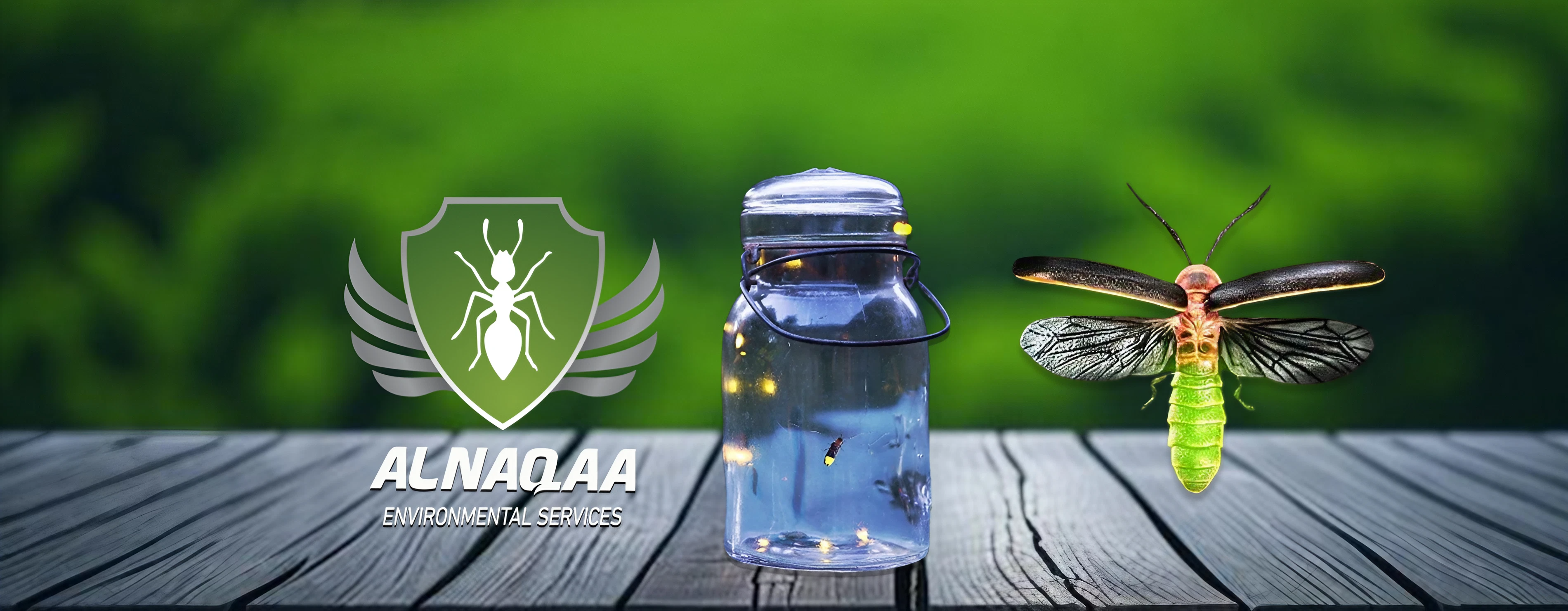Insect Bioluminescence
The phenomenon of bioluminescence is one of nature’s wonders that most captures our interest. Although fireflies are probably the best-known examples, the world of insect bioluminescence is a fascinating and varied one. The ability of living things to create and emit light has independently evolved in several insect species. Alnaqaa for Environmental Services and Pest Control, Ras Al-Khaima, United Arab of Emirates will help you explore the fascinating world of insect bioluminescence in this essay, illuminating its processes, ecological significance, and prospective uses.
The generation and emission of light by living things, as a result of a biological reaction, is known as bioluminescence. Insects have developed complex mechanisms to produce this ethereal glow, which often involves the interaction of luciferin, a chemical that emits light, and luciferase, an enzyme that catalyzes the reaction. Specialized light-emitting organs, which are frequently found in the insect’s abdomen or thorax, are where the chemical reaction takes place.
Each species displays its bioluminescent patterns, colors, and blinking rhythms, which are used for a variety of purposes, including luring prey, attracting mates, and warning off predators. Green, yellow, red, and even blue light can all be produced with a wide range of intensity and color. Several insect groups have harnessed this unique ability, such as:
1. Fireflies: Perhaps the most well-known bug for bioluminescence is the firefly. Males produce recognizable light flashes to entice females to mate. Each species has a distinctive flash pattern that serves as a courting signal for that species only. During warm summer nights, watching fireflies flash in unison is a spellbinding sight. Luciferin and luciferase enzymes participate in a chemical reaction that causes fireflies to emit light.
2. Glowing worms: The bioluminescent shine of glow worms, which are related to fireflies, is well known. They generate a continuous light throughout the larval stage to draw small invertebrates as prey. When exposed to air, the luciferin-containing mucus that the glow-worm larvae secrete causes a greenish glow. They can draw unwary creatures into their sticky snares thanks to this adaptability.
3. Railroad Worms: A class of insects known as glow-worm beetles, railroad worms are bioluminescent. To draw prey, the larvae and adult females give forth a greenish glow. The men, however, lack this skill. The shining larvae of railroad worms are thought to attract and catch small invertebrates using their bioluminescent light, which is thought to be largely used for predation.
4. Click Beetles: On their thorax, several species of click beetles have bioluminescent structures termed “lateral organs.” These beetles start emitting light as a defense mechanism when they feel threatened or disturbed. Predators are startled by the abrupt flash of light, giving the click beetles a chance to flee.
5. Lanternflies: In their nymphal stage, tropical lanternflies display bioluminescence. They have “lanterns,” which are organs on their abdomen that produce light. It is thought that the bioluminescent display serves as a warning message to potential predators, signaling their toxicity or unpalatability.
6. Train Worm Beetles: Native to Central and South America, railroad worm beetles are renowned for their stunning bioluminescent displays. To communicate with possible mates, the adult beetles send out a series of flashes that are greenish-yellow in color. In the nighttime forest, males and females synchronize their flashing patterns to produce an amazing show.
These small animals use bioluminescence for a variety of functions, from luminous glow worms to flashing fireflies. This article examines some well-known examples of bioluminescent insects and delves into the precise roles that this luminous adaption plays in their daily lives.
An important part of the intricate web of ecological relationships is played by insect bioluminescence. Mate attraction is one of the main functions. For instance, male fireflies send out regular flashes to communicate and locate potential partners. Successful reproduction is ensured by the distinct blinking patterns and frequencies that serve as species-specific signals. Both scientists and nature lovers have been entranced by the amazing synchronicity of firefly flashes during courtship displays.
Insects use bioluminescence as a key defense mechanism. Some animals use their luminous traits to alert predators to their poisonousness or unpalatability. For instance, firefly larvae give off a warning glow to dissuade predators from eating them. In some instances, the light that is emitted mimics other organisms’ warning signs that are poisonous or repulsive to predators.
Insect bioluminescence is frequently used to draw in prey as well. Predatory insects use their glow to entice unaware insects into their neighborhood as predatory beetles do. These “light traps” offer a misleading attraction that draws prey in and improves the likelihood of capture.
Insect bioluminescence holds ecological significance in several ways. Here are some key aspects:
1. Mate Attraction: Bioluminescent displays are often used by insects as a means to attract mates. Male fireflies, for example, emit species-specific light patterns or flashes to signal their presence and quality to receptive females. The synchronization of flashing patterns within firefly populations enhances mating success.
2. Species Recognition: Bioluminescence helps insects identify and recognize individuals of their own species. Each species typically has a unique light pattern or flash frequency, allowing individuals to distinguish conspecifics from other species. This plays a crucial role in ensuring successful mating and avoiding costly reproductive errors.
3. Predation Defense: Some bioluminescent insects use their light-producing capability as a defense mechanism against predators. When threatened, they may suddenly emit a bright burst of light, startling or confusing their attackers. This behavior serves to startle or deter predators and provides the insect with an opportunity to escape predation.
4. Warning Signals: In certain cases, bioluminescence acts as a warning signal to potential predators, indicating that the insect is unpalatable, toxic, or dangerous. By emitting light, these insects advertise their unprofitability as prey, deterring predators from attacking them.
5. Social Communication: Bioluminescence facilitates communication within social insect groups. Some species of glowworms, which are actually the larvae of certain beetles, emit a steady glow to attract prey such as insects or small invertebrates. The light serves as a lure, attracting prey into their sticky silk threads.
6. Habitat and Niche Differentiation: Bioluminescence can contribute to niche differentiation and reduce competition among species. Different species may have unique light emission patterns, allowing them to occupy specific ecological niches without interference from other bioluminescent insects.
7. Circadian Rhythms and Environmental Signals: The timing and intensity of bioluminescent displays in insects often follow circadian rhythms. These rhythms can be influenced by environmental factors such as temperature, humidity, and moonlight. Bioluminescence serves as a means for insects to synchronize their behavior with environmental cues.
Understanding the ecological significance of insect bioluminescence provides insights into the intricate relationships between insects, their environment, and other organisms. It showcases the diverse ways in which insects utilize light as a tool for survival, reproduction, and communication.
In conclusion, Insect bioluminescence is a captivating phenomenon that illuminates the natural world and sparks our curiosity.
Insect bioluminescence has diverse applications in science and technology. It aids in studying insect behavior, ecological interactions, and population dynamics. Bioluminescent insects inspire the development of novel biomimetic lighting systems, biosensors, and imaging techniques. They also contribute to medical research, genetic engineering, and environmental monitoring, making them valuable tools in various fields.
The intricate mechanisms, diverse functions, and ecological significance of insect bioluminescence continue to fascinate scientists and researchers worldwide. From mate attraction and defense mechanisms to potential biomedical and technological applications, the glow of these tiny creatures holds immense potential for expanding our understanding of biology and inspiring innovative solutions. As we delve deeper into the secrets of insect bioluminescence, we uncover not only the wonders of nature but also possibilities for a brighter and more sustainable future.






